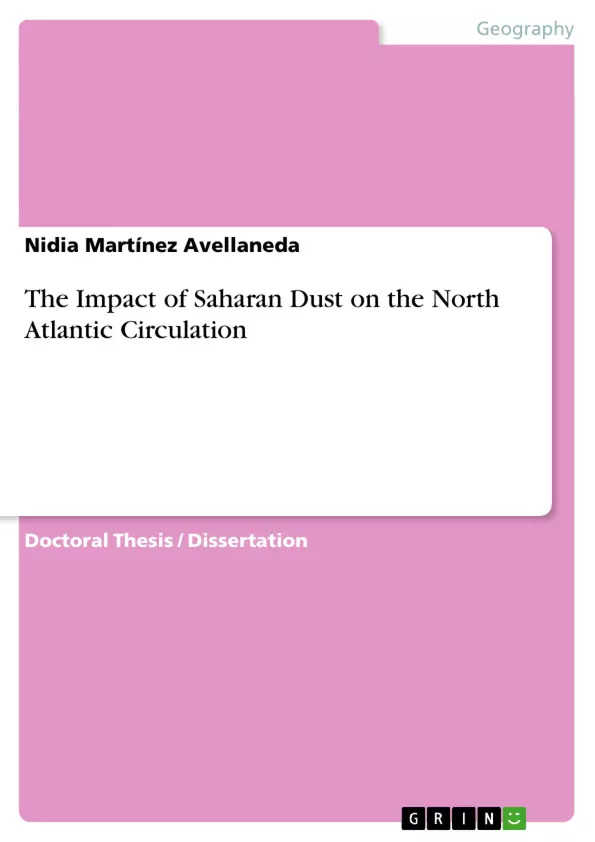The erosion of Saharan soil is the World's largest annual source of mineral dust aerosols, resulting in a deposition of more than 40% of the global atmospheric dust into the North Atlantic (NA). By changing the atmospheric opacity, mineral dust can alter the shortwave radiative forcing at the surface of the ocean, altering the ocean mixed layer heat budget and therefore affecting the sea surface temperature (SST). Moreover, changes of the total amount of energy received at the ocean surface have an impact on the ocean circulation. In this thesis we combine several satellite observations, in-situ radiation measurements, a 1D mixed layer model of the ocean, and various versions of a 3D general ocean circulation model, to study the impact of Saharan dust on the circulation of the NA. A buoyancy source generated by realistic dust-induced shortwave flux anomalies is imposed in the eastern NA and the differences between this simulation and an unperturbed one are investigated in terms of the ocean dynamical adjustment and changes in the Atlantic Meridional Overturning Circulation (AMOC). A joint analysis of aerosol optical depth retrievals from the MODIS sensor and SST from the TMI sensor for the period 2000-2006 shows a decrease in SST of 0.2° to 0.4°C simultaneously with, or shortly after, strong dust outbreaks, which is consistent with an independent estimate of SST decrease simulated by a local 1D mixed layer model. A comparison between observed TMI SST fields and simulated SSTs with an eddy-permitting model of the NA suggests a local cooling of about 0.5°C on sub-seasonal to interannual time-scales. Results of the 3D simulations show that an advection of the ocean properties ocurs in response to the buoyancy source in the eastern subtropical NA. The eddies and baroclinic instabilities present in the ocean advect the signal towards the west and back towards the east. Once they have reached the African coast, they trigger westward propagating Rossby waves. The time-mean differences of AMOC between the perturbed and unperturbed simulations show an increased meridional transport at 38°N and 43°N of 0.55 and 0.45 Sv, respectively, and a decreased AMOC at 40°N and 45°N of 0.2 Sv. We conclude that the effect of Saharan dust should be incorporated in ocean numerical simulations, specially under the frame of climate change studies when a changing dust load of the atmosphere in response to a changing climate could be possible.
Inhaltsverzeichnis (Table of Contents)
- Introduction
- Aims
- Structure
- Response of the eastern subtropical North Atlantic sea surface
temperature to Saharan dust
- Introduction
- Data and Methodology
- MODIS AOD
- TMI SST
- Aerosol Radiative Forcing during AEROSE-I
- Observed SST and AOD anomalies
- Simulated SST anomalies in the ocean mixed layer
- Isolating dust-induced SST anomalies
- Model description
- Model setup
- Results from 3D eddy-permitting simulation
- Concluding remarks
- Impact of Saharan Dust on the North Atlantic Circulation
- Introduction
- Methods
- The experimental setup
- Construction of a realistic perturbation
- Mean ocean circulation
- Perturbed response
- Large-scale response
- Sub-basin and local response
- Vertical structure of temperature anomalies
- Meridional Overturning and Heat Transport in the Atlantic
- Discussion and Conclusions
- Conclusions
- Summary
- Outlook
Zielsetzung und Themenschwerpunkte (Objectives and Key Themes)
This dissertation investigates the impact of Saharan dust on the North Atlantic Ocean, focusing on its effects on the local sea surface temperature and the larger scale circulation. The primary aim is to understand how dust-induced changes in the ocean interact with other existing dynamical features, and to determine the magnitude and extent of these impacts.
- Impact of Saharan dust on sea surface temperature (SST)
- Influence of dust on ocean circulation and transport properties
- Role of dust-induced buoyancy anomalies on the Atlantic Meridional Overturning Circulation (AMOC)
- Effect of dust on the meridional heat transport in the Atlantic Ocean
- Relationship between dust variability and the propagation of Rossby waves
Zusammenfassung der Kapitel (Chapter Summaries)
- Chapter 2: This chapter examines the relationship between Saharan dust and sea surface temperature in the eastern subtropical North Atlantic. It analyzes satellite data from MODIS and TMI sensors, as well as in-situ measurements from the AEROSE campaign. The chapter also presents the results of simulations using a one-dimensional mixed layer model and a three-dimensional eddy-permitting general circulation model.
- Chapter 3: This chapter investigates the impact of Saharan dust on the North Atlantic circulation using an eddy-permitting ocean general circulation model (OGCM). The chapter focuses on the response of the ocean circulation to a realistic dust-induced buoyancy perturbation in the eastern subtropical North Atlantic. It analyzes the changes in simulated sea surface temperatures and heights, as well as the impact on the AMOC and meridional heat transport.
Schlüsselwörter (Keywords)
The primary keywords and focus topics of this dissertation include Saharan dust, sea surface temperature (SST), sea surface height (SSH), aerosol radiative forcing, North Atlantic circulation, Rossby waves, AMOC, meridional heat transport, and ocean modeling.
- Citation du texte
- Nidia Martínez Avellaneda (Auteur), 2010, The Impact of Saharan Dust on the North Atlantic Circulation, Munich, GRIN Verlag, https://www.grin.com/document/146039



